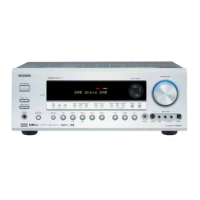
Do you have a question about the Onkyo TX-SR653E and is the answer not in the manual?
| Channels | 7.2 |
|---|---|
| HDMI Inputs | 6 |
| Dolby Atmos | Yes |
| DTS:X | Yes |
| Wi-Fi | Yes |
| Bluetooth | Yes |
| Multi-room Audio | Yes |
| HDMI Version | 2.0 |
| HDCP Version | 2.2 |
| AirPlay | Yes |
| Spotify Connect | Yes |
| TIDAL | Yes |
| Deezer | Yes |
| Internet Radio | Yes |
| Zone 2 | Yes |
| Frequency Response | 10 Hz - 100 kHz |
| Total Harmonic Distortion | 0.08% |
| Input Sensitivity | 200 mV |
| Video Outputs | 1 |
| Digital Audio Inputs | 2 Optical, 1 Coaxial |
| Phono Input | Yes |
| Multi-room Output | Yes |
| FM Tuner | Yes |
| AM Tuner | Yes |
| Amplifier Type | Class AB |
| Power Output (8 ohms) | 100 W |
| HDMI Outputs | 2 |
| Signal-to-Noise Ratio | 106 dB |
| Dimensions (W x H x D) | 435 x 173.5 x 378 mm |
Specific precautions and FCC information for US models.
Details on compliance with FCC rules for digital devices.
Compliance note for Canadian Class B digital apparatus.
Details on amplifier specifications like power output and channels.
Description of audio and video processing capabilities.
Information on AM/FM/DAB tuning capabilities.
Additional features like speaker setup microphone.
Identification and function of front panel controls and indicators.
Explanation of the information shown on the AV receiver's display.
Detailed layout and explanation of rear panel input/output jacks.
Instructions for inserting batteries into the remote control.
Guidance on pointing the remote and optimal usage conditions.
Explanation of different operating modes for controlling various components.
Recommendations for positioning front, center, and surround speakers.
General guidelines for making audio and video connections.
Guide to connecting speakers for optimal surround sound experience.
Instructions for connecting FM, AM, and DAB antennas.
Methods for connecting video and audio signals to your display.
Steps for connecting DVD players via video and audio interfaces.
Connecting satellite, cable, set-top boxes, and LD players.
Details on connecting CD players using digital or analog audio.
Guidance on connecting turntables with or without phono preamps.
How to connect and control compatible Onkyo components via RI.
Step-by-step guide to powering on the AV receiver.
Guide to automatic speaker configuration using a microphone.
Overview of navigating setup menus displayed on the TV.
Assigning digital input jacks to input selectors.
Assigning component video inputs and configuring outputs.
Setting the minimum speaker impedance for safety.
Specifying the TV format (Auto, PAL, NTSC) for your region.
Specifying connected speakers and their sizes.
Setting distances from speakers to the listening position.
Adjusting individual speaker volume levels using test tones.
Adjusting the equalizer for individual speakers.
Customizing input source names for RI-compatible components.
How to choose the AV component to listen to or watch.
Using sleep timer, display brightness, muting, and headphones.
Viewing details about the current input source and signal format.
Tuning AM/FM/DAB stations, presets, and RDS features.
Guide to choosing surround sound and audio playback modes.
Descriptions of various surround sound and audio playback modes.
Using CinemaFILTER and Late Night functions for audio.
Adjusting speaker levels and using DVD multichannel input.
How to record audio and video from input sources.
Configuring bass, treble, and detailed audio processing settings.
Assigning default listening modes to input sources.
Customizing display, scan mode, remote ID, and input formats.
Manually setting digital input signal formats (PCM or DTS).
Modifying the remote control ID to avoid code conflicts.
Methods for connecting speakers or amps for multi-room audio.
Configuring powered zone settings to enable Zone 2 speakers.
Steps to turn on, select sources, and adjust volume for Zone 2.
Using 12V Trigger and Multiroom Kits for Zone 2 control.
How to enter codes to control other AV devices with the remote.
Managing RI component codes, resetting modes, and the controller.
Specific instructions for controlling TVs, VCRs, and satellite receivers.
How to teach the remote controller new commands from other remotes.
Programming macro buttons to perform sequences of actions.
Technical details for power output, dimensions, and power supply.
Technical details for video inputs/outputs and tuner frequency ranges.
List of all available audio, digital, and other connection ports.
Solutions for no sound, low volume, or power issues.
Troubleshooting reception, remote control, and component connectivity.
Resolving display, language, Zone 2, and receiver reset problems.
